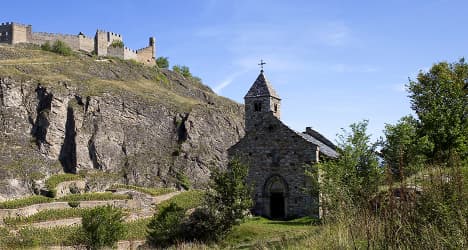Sion’s deathly history brought to life in new exhibition

Visitors to Sion will be able to explore the history of funeral rites in Switzerland over the past 7,000 years in a series of exhibitions and events starting this spring.
Archaeological evidence of human life in the Sion area, in the canton of Valais, dates back some 10,000 years and is particularly revealing about traditions and beliefs surrounding death and the afterlife.
Tombs and cemeteries dating back to the Neolithic period are present within a one kilometre area, making Sion a unique archaeological site in Switzerland.
From April 16th a series of events under the banner ‘10,000 years beneath the ground’ will aim to promote this special heritage to the public.
Among them is a walking tour (running to August 28th) taking in cemeteries from the past seven millennia, including Iron Age tombs, a Neolithic necropolis and an 8th century crypt.
Meanwhile at the city’s Penitencier museum an exhibition (to January 8th) will present artefacts relating to burial rites over a period of 7,000 years, from the Neolithic era to the Celtic period, the Roman Empire and the present day.
Speaking to The Local, cantonal archaeologist Caroline Brunetti said: “Compared with other towns in Switzerland, in Sion we have a historical continuity that is absolutely exceptional. We have cemeteries that are very representative of the period from 5,000 BC to today.”
“What’s important is the longevity, the fact that we have cemeteries that are very well conserved over a very long period.”
Artefacts from the sites include effigies, gold and bronze Neolithic jewellery, arms belonging to Celtic warriors and engraved steles – or tombstones – dating from 5,000BC “which are absolutely unique in Europe,” said Brunetti. “They are really magnificent”.
Also among Sion’s cachet is a cemetery from the 800BC where people were buried with vast riches beside them, and another from the Roman period containing well preserved statues representing divinity and animals, said Brunetti.
The sheer variety of objects reveal the diversity of beliefs over the millennia and that “death was a totally integrated part of society”, the museum said in a statement.
“Changes in burial and cremation over the course of millennia reveal the evolution of concepts surrounding death and the afterlife,” it said.
A brochure entitled ‘Sion, immortal city’ will accompany the events.
Comments
See Also
Archaeological evidence of human life in the Sion area, in the canton of Valais, dates back some 10,000 years and is particularly revealing about traditions and beliefs surrounding death and the afterlife.
Tombs and cemeteries dating back to the Neolithic period are present within a one kilometre area, making Sion a unique archaeological site in Switzerland.
From April 16th a series of events under the banner ‘10,000 years beneath the ground’ will aim to promote this special heritage to the public.
Among them is a walking tour (running to August 28th) taking in cemeteries from the past seven millennia, including Iron Age tombs, a Neolithic necropolis and an 8th century crypt.
Meanwhile at the city’s Penitencier museum an exhibition (to January 8th) will present artefacts relating to burial rites over a period of 7,000 years, from the Neolithic era to the Celtic period, the Roman Empire and the present day.
Speaking to The Local, cantonal archaeologist Caroline Brunetti said: “Compared with other towns in Switzerland, in Sion we have a historical continuity that is absolutely exceptional. We have cemeteries that are very representative of the period from 5,000 BC to today.”
“What’s important is the longevity, the fact that we have cemeteries that are very well conserved over a very long period.”
Artefacts from the sites include effigies, gold and bronze Neolithic jewellery, arms belonging to Celtic warriors and engraved steles – or tombstones – dating from 5,000BC “which are absolutely unique in Europe,” said Brunetti. “They are really magnificent”.
Also among Sion’s cachet is a cemetery from the 800BC where people were buried with vast riches beside them, and another from the Roman period containing well preserved statues representing divinity and animals, said Brunetti.
The sheer variety of objects reveal the diversity of beliefs over the millennia and that “death was a totally integrated part of society”, the museum said in a statement.
“Changes in burial and cremation over the course of millennia reveal the evolution of concepts surrounding death and the afterlife,” it said.
A brochure entitled ‘Sion, immortal city’ will accompany the events.
Join the conversation in our comments section below. Share your own views and experience and if you have a question or suggestion for our journalists then email us at [email protected].
Please keep comments civil, constructive and on topic – and make sure to read our terms of use before getting involved.
Please log in here to leave a comment.